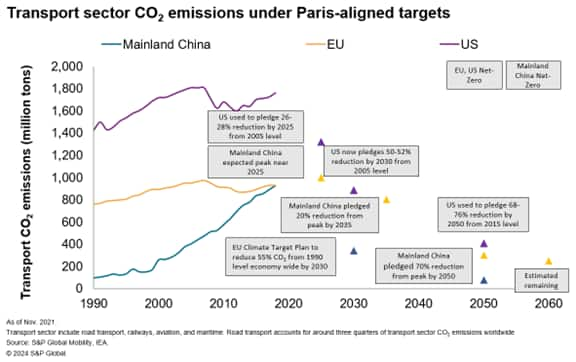Discover more about S&P Global's offerings
Customer Logins
Obtain the data you need to make the most informed decisions by accessing our extensive portfolio of information, analytics, and expertise. Sign in to the product or service center of your choice.
Customer Logins
WHITEPAPER
Jul 19, 2024
China’s Focus on Sustainable Transportation Heats Up
China's aggressive advancement of regulations and sustainability measures to reduce transportation emissions signifies a decisive stride toward its environmental goals.
These measures are:
- Increasing stringency of corporate average fuel consumption policy to decrease vehicle tailpipe emissions.
- Introducing a dual-credit framework for new energy vehicles to raise the adoption of electric vehicles.
- Developing a China Circular Economy Plan focused on battery recycling.
- Enforcing interim regulations for carbon emission trading.
- Promoting the issuance of green bonds to support sustainable finance endeavors.
Mainland China, as the largest global emitter of greenhouse gases, pledges carbon neutrality by 2060, a commitment critical to the global effort to limit global warming under the Paris Agreement goals. This endeavor aims to keep the rise in global temperature below 2 degrees Celsius, ideally 1.5 degrees. A pivotal aspect of this effort involves transitioning the transportation sector to low-carbon alternatives, given its significant contribution to emissions within China.
China transport sector decarbonization
The transportation sector accounts for over 27% of China's total greenhouse gas emissions, with projections estimating it will reach its emission peak between 2025 and 2035 — potentially even earlier if policies are implemented effectively, possibly before 2030. Through initiatives such as vehicle electrification and enhancements in fuel efficiency, emissions could decline by 50%-95% from 2020 levels by 2060. The transport sector also accounts for 20%-50% of PM2.5 emissions in cities and is a major emitter of nitrogen oxides (NOx) and volatile organic compounds (VOCs) nationwide.

Concurrently, China is also tightening controls on coal use, enhancing non-fossil energy sources and halting new overseas coal projects, reflecting its commitment to environmental sustainability. Moreover, an investment of over $546 billion in 2022 was made for new energy technologies, indicating its push for a sustainable shift in energy and industry.
Read S&P Global Mobility's whitepaper for an in-depth analysis on mainland's China's 5 goals for sustainable transport.
This article was published by S&P Global Mobility and not by S&P Global Ratings, which is a separately managed division of S&P Global.
{"items" : [
{"name":"share","enabled":true,"desc":"<strong>Share</strong>","mobdesc":"Share","options":[ {"name":"facebook","url":"https://www.facebook.com/sharer.php?u=http%3a%2f%2fstage.www.spglobal.com%2fmobility%2fen%2fresearch-analysis%2fchina-sustainability-transportation-regulations.html","enabled":true},{"name":"twitter","url":"https://twitter.com/intent/tweet?url=http%3a%2f%2fstage.www.spglobal.com%2fmobility%2fen%2fresearch-analysis%2fchina-sustainability-transportation-regulations.html&text=China%e2%80%99s+Focus+on+Sustainable+Transportation+Heats+Up+%7c+S%26P+Global+","enabled":true},{"name":"linkedin","url":"https://www.linkedin.com/sharing/share-offsite/?url=http%3a%2f%2fstage.www.spglobal.com%2fmobility%2fen%2fresearch-analysis%2fchina-sustainability-transportation-regulations.html","enabled":true},{"name":"email","url":"?subject=China’s Focus on Sustainable Transportation Heats Up | S&P Global &body=http%3a%2f%2fstage.www.spglobal.com%2fmobility%2fen%2fresearch-analysis%2fchina-sustainability-transportation-regulations.html","enabled":true},{"name":"whatsapp","url":"https://api.whatsapp.com/send?text=China%e2%80%99s+Focus+on+Sustainable+Transportation+Heats+Up+%7c+S%26P+Global+ http%3a%2f%2fstage.www.spglobal.com%2fmobility%2fen%2fresearch-analysis%2fchina-sustainability-transportation-regulations.html","enabled":true}]}, {"name":"rtt","enabled":true,"mobdesc":"Top"}
]}


